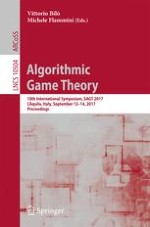2017 | Buch
Algorithmic Game Theory
10th International Symposium, SAGT 2017, L’Aquila, Italy, September 12–14, 2017, Proceedings
herausgegeben von: Vittorio Bilò, Prof. Michele Flammini
Verlag: Springer International Publishing
Buchreihe : Lecture Notes in Computer Science
